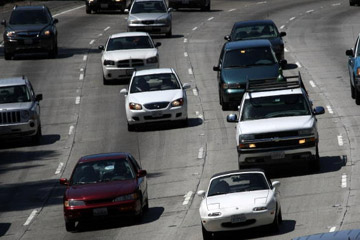................................
Road Markings
By Steve Wallace, Times Colonist
Road markings are often confusing not
only to new drivers, but also many experienced drivers as well.
Here
is a refresher-reminder of their meaning.
Yellow centre road lines separate
opposite flows of vehicular traffic. A broken yellow centre line on a two-way
road means passing is permitted when safe to do so.
Some drivers are surprised to learn
that a single solid yellow centre line on a two-lane road also means passing is
permitted “with extra caution.”
Always
be aware of a driver who attempts to pass when the centre line is solid. Many
such drivers do not exercise the necessary “extra caution” required for such a
pass.
Double solid lines mean no passing in
any direction.
A
broken yellow line parallel to a solid means the traffic on the broken side of
the road can pass when safe to do so. Traffic on the solid side of the
configuration is not permitted to pass.
White centre lines separate traffic
moving in the same direction. These lines are most noticeable on one-way
streets. A solid white line means do not change lanes.
A
solid white line at the side of the roadway means drivers are not permitted to
cross that line to go around someone turning left from the highway or roadway.
Many
municipalities have removed these lines because they cause bottlenecks when
drivers are held up by left-turners on single-lane roads.
A thick solid white line at a stop
sign means stop before the line.
Intermittent
vertical thick white lines designate crosswalk areas that are not accompanied
by a stop sign or a normal traffic-light system.
Drivers
must stop when pedestrians intend to cross at these locations. Some more modern
alternating yellow lights will be placed at these “zebra” style crosswalks to
alert drivers to pedestrian traffic.
It
is not necessary to remain stopped until the lights have stopped flashing.
Drivers may proceed once the pedestrians have cleared the intersection.
Parallel horizontal white lined
crosswalks are at a traffic-light or stop-sign intersection. These parallel
crosswalks are busier than “zebra” crosswalks.
Drivers
are more aware at parallel solid-lined crosswalks because of the predictability
of large groups of inner-city pedestrians.
Drivers
often get accustomed to travelling through several “zebra” crosswalks without
the presence of pedestrians and get lulled into a false sense of security when
approaching them.
Many
more close calls happen at “zebra” crossings than at horizontally lined crosswalks
where stopping at a sign or red traffic light is mandatory.
Drivers
must stop at stop signs, even when municipalities paint “zebra” lines in error,
where solid crosswalk lines should be placed.
Many inner-city roads have a solid
white line separating a diamond or bicycle symbol from the regular travelled
portion of the road.
These
symbols show the type of traffic that is restricted to a particular lane. This
special traffic flows in the same direction as regular traffic.
Vehicle
drivers may not drive in bicycle lanes except where dashed white lines are
painted, usually close to intersections.
Yellow painted islands are there to
tell drivers to stay to the right of the diagonal yellow stripes and to not
drive on or over them. They are meant to act as imaginary boulevards.
Double broken yellow lines show lanes
that are reversible. Overhead lane-control red/yellow/green lights will show
drivers whether they can use each lane.
A two-way oncoming left-turn lane is
designated by inside broken yellow lines accompanied by outside solid yellow
lines.
Drivers
travelling in opposite directions share this lane for left turns. Drivers are
permitted to make turns only and may not use this kind of lane to advance their
forward travel.
So much for the refresher — hope you
enjoyed it.
Steve Wallace is the owner of Wallace Driving School on
Vancouver Island and in the Central Interior of B.C. He is the former Western
Canadian vice-president of the Driving Schools Association of the Americas.
Steve is a registered B.C. teacher and a graduate of the University of
Manitoba.
http://www.wallacedrivingschool.com/do-you-really-know-your-road-markings/
You might also like:
CLICK HERE . . . to view . .
.
http://puricare.blogspot.com/2017/12/basic-road-markings-in-ph-reading-road.html
...........................................................................................................
...........................................................................................................
CLICK HERE . . . to view . . .
http://puricare.blogspot.com/2017/06/horizontal-lines-on-road-they-are.html
...........................................................................................................
...........................................................................................................
CLICK HERE . . . to view . . .
...........................................................................................................
CLICK HERE . . . to view . . .
http://puricare.blogspot.com/2019/03/driving-safely-no-one-plans-to-get-into.html
...........................................................................................................

...........................................................................................................
CLICK HERE . . . to view . . .



:max_bytes(150000):strip_icc():format(webp)/view-from-the-top-of-a-car-driving-down-a-motorway-at-speed-564186969-59ca59f4af5d3a0010b8e0af.jpg)


No comments:
Post a Comment